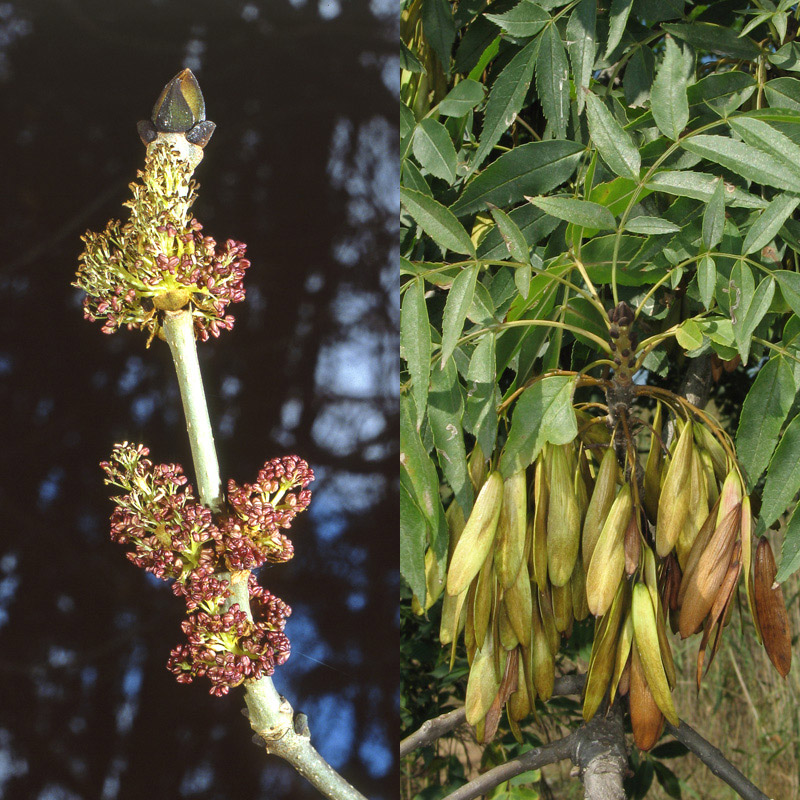Botanical name
Fraxinus excelsior L.
Fraxinus angustifolia Vahl
Family
Oleaceae
Common name
F. excelsior - Ash, Common ash, European ash
F. angustifolia - Narrow-leaved ash, Desert ash
Information about the plant
The trees of the genus Fraxinus are widespread in the Northern Hemisphere, with around 60 species, the most common being the common ash (F. excelsior). It grows in hillside, alluvial and hornbeam forests, always avoiding moisture. The tree grows up to 30 m high (rarely up to 40 m) and is easily identified by its large, odd-pinnate leaves with up to 13 lanceolate, finely serrated leaflets. The inflorescences rest in black winter buds until they open in spring long before the leaf buds open. Numerous crownless flowers are then borne in dense panicles on the stems of the same year. The flowering time is from April to May. In late summer, the tongue-shaped, winged fruits hang in dense clusters on thin stems.
The genus name Fraxinus is derived from the Greek 'phraxis' (= splitting, separation) because the wood is easy to split. This may be why it was used in the past to make spears and tools. The species epithet excelsior refers to the size of the tree (Latin 'excelsior' = higher, loftier). The species epithet angustifolia of the narrow-leaved ash describes the shape of the leaflets (Latin 'angustus' = narrow, 'folium' = leaf).
Medicinally used parts of plants (herbal drug)
The dried leaves (ash leaves - Fraxini folium) harvested in early summer and the bark (ash bark - Fraxini cortex) of younger twigs are used.
Constituents of the herbal drug
Ash leaves contain flavonoids, hydroxycinnamic acid derivatives, iridoid bitter substances and tannins. Ash bark contains iridoid bitter substances and coumarins.
Quality of the drug
The quality of ash leaves (Fraxini folium) is specified in the European Pharmacopoeia (Ph. Eur.). There is no pharmacopoeial quality description for ash bark (Fraxini cortex).
Medical applications
Recognised medical use
The HMPC has classified ash leaves as a traditional herbal medicinal product (see "Traditional use").
ESCOP: Ash leaves have not yet been evaluated.
Ash leaves are used in folk medicine for rheumatism, gout, bladder problems, against fever and as a tonic.
Traditional use
Ash leaves have been classified by the HMPC as a traditional herbal medicinal product (§ 39a AMG). Based on many years of experience, ash leaves can be used for mild joint pain and to increase the amount of urine and thus to flush out the urinary tract as a supportive treatment for urinary tract complaints.
Herbal drug preparations in finished dosage forms
- Cut ash leaves for tea preparation
- Alcoholic extract of fresh bark in drops
- F. excelsior homeopathic mother tincture of the leaves in liquid preparations
Dosage
Finished medicinal product: see patient information leaflet.
Tea infusion: Drink a cup of ash leaf tea several times a day. Daily dose 10 to 30 g drug. In the case of urinary tract complaints, a combination with other drugs such as orthosiphon leaves, hay root, goldenrod, birch leaves, or nettle is also recommended.
Preparation of a tea
Pour 150 mL of boiling water over 1.5 to 5 g of finely chopped ash leaves and strain after approx. 10 minutes.
Notes
If ash leaves are used for flushing therapy, it is important to drink a lot of liquid. Ash leaf preparations must not be taken in cases of cardiac insufficiency or kidney disease. If fever, urinary retention, cramps when urinating or blood in the urine occurs during treatment, it is essential to consult a doctor; the same applies if the joints swell up from inflammation and fever occurs.
Side effects
None known
Interactions
None known
References
Herbal drug monographs
HMPC (2012, 2022)
Further literature
Commentary on the European Pharmacopoeia (Ash leaves, Nr. 1600)


